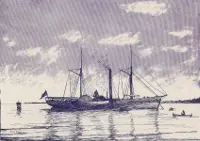The Making of the 50 States: Michigan
Part 2: The Rest of the Story Some parts of Michigan were strongly in favor of continued British rule during the Revolutionary War and demonstrated this by raiding American settlements during the war. Although the United States gained control of the Michigan area at the conclusion of the war, Fort Detroit and Fort Mackinac did not surrender until 1796, after Michigan was part of the Northwest Ordinance of 1787. Detroit was the capital of the Michigan Territory, created in 1805; William Hull was the first governor. Michigan had been made part of Indiana Territory in 1800, when France took back control of the overall Louisiana Territory from Spain. The city of Detroit and another nearby fort, Mackinac, surrendered to the British Army during the War of 1812. The U.S. strengthened its presence in Michigan militarily with the arrival of Lewis Cass, appointed as military and civil governor in 1813. After an initial setback in the Battle of Frenchtown, Americans took back Detroit for good at the Battle of Lake Erie (led in part by the brilliant Oliver Hazard Perry). 
In 1819, the Treaty of Saginaw provided for the transfer of 6 million acres of land from Native Americans to American settlers. The Indian Removal Act of 1830 also resulted in a mass migration of Native Americans away from Michigan (and Ohio). Steamboats began showing up regularly on the Great Lakes in the early 19th Century. The opening of the Erie Canal in 1825 brought an increased amount of traffic to Detroit and the wider Michigan area. The University of Michigan was founded in Detroit in 1817. The Historical Society of Michigan came along in 1828. 
A boundary dispute between Indiana, Michigan, and Ohio delayed Michigan's entry into the Union, and Michigan created its own non-American state structure. The federal government got involved and mediate the dispute, clearing the path for Michigan to become a state, which it did, entering the Union as the 26th state on Jan. 26, 1837; the first state capital was Detroit. First page > In the Beginning > Page 1, 2 |
|
Social Studies for Kids
copyright 2002–2024
David White




